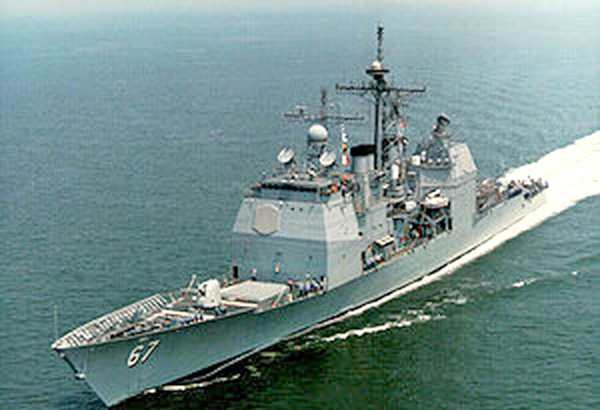I guess what US Defense Secretary Ashton Carter said during military ceremonies in Hawaii when he spoke with Secretary Voltaire Gazmin is no longer lip service as far as their commitment to the Philippines is concerned, with the US preparing to take on a more active role in ensuring freedom of navigation in the South China Sea. At the high-level international security meeting dubbed the “Shangri-La Dialogue” in Singapore, Carter called for “an immediate and lasting halt to land reclamation by all claimants” and that America will “oppose any further militarization of disputed features.”

According to Carter, the US is complementing India’s “Act East” policy and leveraging on America’s alliances and partnerships to seek new avenues of cooperation. The US Defense Secretary is visiting India to sign the 2015 US-India Defense Framework that covers everything from maritime security to aircraft carrier and jet engine technology cooperation, underscoring the seriousness of the United States in boosting alliances and strengthening its “trilateral network” in the Asia Pacific region.
The presence in Subic of the US Navy missile cruiser USS Shiloh – forward deployed to Yokosuka in Japan and on patrol at the US 7th Fleet’s area of operations that include security support in the Indo-Asia Pacific region – is part of “routine port call,” according to Commanding Officer Capt. Kurush Morris, who said he is looking forward to getting back into their “routine of visits.” Which means we can expect more of these port calls from US Navy vessels on a rotational basis within the next year.
So far, the Philippines is still waiting for the Supreme Court to issue its ruling on the Enhanced Defense Cooperation Agreement (EDCA), but hopes are high that the decision will be favorable as it will enable the US to expand its presence in the country, not to mention allow the joint use of facilities and equipment between the US and Philippine armed forces – something that would probably irritate China no end.
The fact is, it’s not only the US and the Philippines that are telling China to stop all its reclamation activities in the disputed maritime territories. Australia has also issued a stern warning, following revelations by US defense officials that two big artillery vehicles were placed in one of the artificial islands it is creating. The discovery was made several weeks ago, but China however has since removed the weaponry according to sources.
P-Noy State Visit to Japan important

A large business delegation is joining President Aquino on his state visit to Japan with business matching sessions lined up to increase trade relations between the two countries. Preparations leading to the visit have been round-the-clock, and we must commend our Ambassador to Japan Manolo Lopez for tirelessly working to make sure that the visit is a great success. Over the years, our relations with the Japanese have been getting stronger, especially since Japan happens to be the biggest aid donor to the Philippines.
While trade and commerce will be a top priority during PNoy’s State Visit – with high hopes of increasing Japanese investments into the country – an underlying purpose would be defense and security issues in light of China’s escalating aggression and increasing reclamation activities in the disputed maritime territories in the South China Sea. In fact, a Chinese general attending the Shangri-La Dialogue in Singapore even floated the possibility of setting up an air defense identification zone above the disputed maritime territories – which could further inflame the situation.
Three weeks ago, Japan and the Philippines held the first joint naval exercises in the South China Sea west of Manila, with two Japanese Navy destroyers and 600 personnel taking part. The exercises of course are part of efforts to boost defense relations in light of China’s recent moves. Early this year, both countries signed a memorandum of understanding and just recently, Japan inked a deal to construct 10 multirole response vessels for the Philippine Coast Guard, and a major portion of the funds would come from the Japanese Official Development Assistance tied to the Japan International Cooperation Agency. The new vessels – expected to be delivered in 2016 until 2018 – is part of the government’s efforts to equip its forces with the necessary assets to “protect the national maritime interest.”
Shades of protection
Contrary to notion that sunglasses are more form than function, new evidence suggests that wearing shades can protect the eyes from various conditions including pinguecula – a condition where membranes on the white part of the eye near the cornea thicken, leading to a condition called pterygium which can permanently damage the eyes. This condition is more common among middle-aged and older people who spend more time in the sun.
Apparently, even just one day under the glaring heat of the sun without proper eye protection can result in short-term damage from ultraviolet rays, and this can get more serious with longer exposure. According to a survey conducted by The Vision Council, 26 percent of people never or rarely wear sunglasses. About 58 percent of Americans spend the most time outdoors during times when ultraviolet rays are strongest (8-10 am and 2-4pm) and therefore more risky for the eyes.
Interestingly, those with blue eyes are more susceptible because they have less of melanin. Aside from cataracts, macular degeneration, pinguecula and eye sunburn, temporary vision loss (which could lead to permanent blindness) are among the risks of too much sun exposure.
***
Email: spybits08@gmail.com
source: Philippine Star
No comments:
Post a Comment